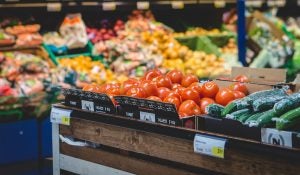In supermarket conversations (and yes, I do have them) people are scared to death about their fruits and vegetables. I eat fruits and vegetables, all of them, and a lot of them. My kick-ass garden, farmers’ markets, grocery stores, roadside stands — I love fresh fruits and vegetables. I buy conventional and sometimes organic if it is from a friend’s farm. I buy to support my state’s farmers, and choices are also influenced by meal ideas for the week.
My garden rocks. I use lots of pesticides and synthetic fertilizers, safely, and without hesitation. I’m a scientist at a major university that works with ag. I see what farmers spray and how they do it. I understand the chemistry. I’m keenly aware of realistic risk, so I’m not afraid of my food.
Recently, the Environmental Working Group’s (EWG) “Dirty Dozen” list slinked out of its fear cave again, the annual extrapolation of government statistics that is published to scare consumers and influence buying choices. For those unaware of this annual fear campaign, the EWG publishes a list of “dirty” produce, claiming that they are woefully contaminated with pesticide residues that will kill us all. The goal is to erode trust in conventional agriculture and promote a transition to pricey organic alternatives.
Here’s why we need to reject the Dirty Dozen:
1. It creates a false sense of food risk where next to none exists.
They are not a testing organization. They acquire numbers from USDA tests, tests that are done to monitor the safety of chemistry use on the farm. The results overwhelmingly show that food is safe, and that the levels of chemicals detected are extremely small. Typically they are at parts per billion (seconds in 32 years) and way more than thousands of times below safe daily consumption levels. EWG claims that many are found on one piece of fruit, when farmers typically never use the combinations reported. They are lumping statistics together to scare consumers.
2. It perpetuates fear of chemistry that is used safely.
The point of the USDA survey is to verify that chemistry is being used safely, and it is. EWG simply bends and reports the numbers in an effort to scare consumers. Your food is not “dirty” and that’s what the USDA shows with these tests. They say that strawberries are #1 dirty. Strawberry scientists and farmers let their kids eat them too, right out of the field.
They use stats of residues on fresh fruits and vegetables, not consumer exposure, which is even lower than the amounts detected. We have technology that is very good at detecting next to nothing.

3. It harms farmers.
Farmers use crop protection products with great responsibility. After all, it is on their farm, they are applying it, and it typically is being applied near where their families and pets reside. Ag chemicals cost a lot of money. Application takes time, labor, and fuel. They are applied as little as possible. The familiar trope of farmers dousing a field in 35 chemicals is a massive exaggeration, and one clearly perpetuated by EWG’s Dirty Dozen.
Worse, when consumers turn against fresh fruits and vegetables, it impacts the farmers’ bottom line. Nowadays the thin margins can’t tolerate well-funded scare campaigns.
4. It discourages consumption of fresh fruits and vegetables.
Probably the greatest harm done by the Dirty Dozen is how it discourages consumers from eating fruits and vegetables. The perception is that they are “dirty” and covered in toxic chemistry, thanks to campaigns like the Dirty Dozen. At a time when we know that consumption of fresh fruits and vegetables is absolutely tied to better health and less long-term degenerative disease, we should be encouraging their consumption at every turn — not scaring people away.
5. It takes healthy food from the poor.
Many living in poverty in the cities or in rural areas do not have access to fresh fruits and vegetables to begin with. A local mini-mart or convenience store may be the best source, and they may certainly not have access to boutique organic products. When conventional fruits and vegetables are described as risky and dangerous by activists, buying decisions are affected, leading consumers to buy less healthy alternatives, like frozen or processed food.
6. It promotes food waste.
When consumers fail to purchase in-store produce because they believe it is covered in toxic chemicals, they do not purchase it, leading to a greater chance that it will be discarded. We should be promoting the consumption of fruits and vegetables that are available in our stores, minimizing waste and contributing to sustainable production.
There you have it, a half dozen reasons to reject the Dirty Dozen. The Environmental Working Group seeks to tarnish conventional farming, along with vaccines, cell phones, and other modern miracles. These people are not experts in science, they are experts in marketing that use fear to influence consumer decisions.
Celebrate the safest, most diverse, most inexpensive food supply in human history, and eat fresh fruits and vegetables!
Kevin Folta is a land-grant scientist exploring ways to make better food with less input, and how to communicate science. This article was published with his permission. All of Dr. Folta’s funding can be found at kevinfolta.com/transparency.



